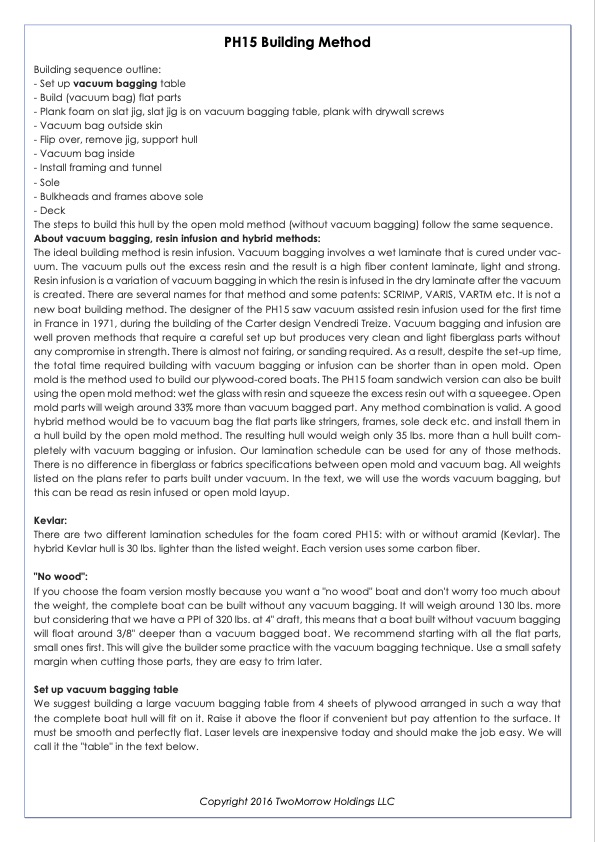
PDF Publication Title:
Text from PDF Page: 001
PH15 Building Method Building sequence outline: - Set up vacuum bagging table - Build (vacuum bag) flat parts - Plank foam on slat jig, slat jig is on vacuum bagging table, plank with drywall screws - Vacuum bag outside skin - Flip over, remove jig, support hull - Vacuum bag inside - Install framing and tunnel - Sole - Bulkheads and frames above sole - Deck The steps to build this hull by the open mold method (without vacuum bagging) follow the same sequence. About vacuum bagging, resin infusion and hybrid methods: The ideal building method is resin infusion. Vacuum bagging involves a wet laminate that is cured under vac- uum. The vacuum pulls out the excess resin and the result is a high fiber content laminate, light and strong. Resin infusion is a variation of vacuum bagging in which the resin is infused in the dry laminate after the vacuum is created. There are several names for that method and some patents: SCRIMP, VARIS, VARTM etc. It is not a new boat building method. The designer of the PH15 saw vacuum assisted resin infusion used for the first time in France in 1971, during the building of the Carter design Vendredi Treize. Vacuum bagging and infusion are well proven methods that require a careful set up but produces very clean and light fiberglass parts without any compromise in strength. There is almost not fairing, or sanding required. As a result, despite the set-up time, the total time required building with vacuum bagging or infusion can be shorter than in open mold. Open mold is the method used to build our plywood-cored boats. The PH15 foam sandwich version can also be built using the open mold method: wet the glass with resin and squeeze the excess resin out with a squeegee. Open mold parts will weigh around 33% more than vacuum bagged part. Any method combination is valid. A good hybrid method would be to vacuum bag the flat parts like stringers, frames, sole deck etc. and install them in a hull build by the open mold method. The resulting hull would weigh only 35 lbs. more than a hull built com- pletely with vacuum bagging or infusion. Our lamination schedule can be used for any of those methods. There is no difference in fiberglass or fabrics specifications between open mold and vacuum bag. All weights listed on the plans refer to parts built under vacuum. In the text, we will use the words vacuum bagging, but this can be read as resin infused or open mold layup. Kevlar: There are two different lamination schedules for the foam cored PH15: with or without aramid (Kevlar). The hybrid Kevlar hull is 30 lbs. lighter than the listed weight. Each version uses some carbon fiber. "No wood": If you choose the foam version mostly because you want a "no wood" boat and don't worry too much about the weight, the complete boat can be built without any vacuum bagging. It will weigh around 130 lbs. more but considering that we have a PPI of 320 lbs. at 4" draft, this means that a boat built without vacuum bagging will float around 3/8" deeper than a vacuum bagged boat. We recommend starting with all the flat parts, small ones first. This will give the builder some practice with the vacuum bagging technique. Use a small safety margin when cutting those parts, they are easy to trim later. Set up vacuum bagging table We suggest building a large vacuum bagging table from 4 sheets of plywood arranged in such a way that the complete boat hull will fit on it. Raise it above the floor if convenient but pay attention to the surface. It must be smooth and perfectly flat. Laser levels are inexpensive today and should make the job easy. We will call it the "table" in the text below. Copyright 2016 TwoMorrow Holdings LLCPDF Image | PH15 Building Method Vacuum Bagging

PDF Search Title:
PH15 Building Method Vacuum BaggingOriginal File Name Searched:
ph15-building-method.pdfDIY PDF Search: Google It | Yahoo | Bing
5,000 BF Shipping Container Lumber Dry Kiln For Quality Lumber The 5,000 BF container kiln consists of one 40 foot high-cube aluminum shipping container... More Info
Shipping Container Lumber Dry Kilns by Global Energy Global Energy designed and developed the container kiln back in 1991. The purpose is to give access to portable sawmill owners, furniture makers, and small business the value added profit of dry kiln lumber and quality hardwoods... More Info
Vacuum Kiln Conversion Kit for Lumber and Wood Dry Kilns Convert your existing conventional dry kiln into a fast drying vacuum kiln. Similar to vacuum bagging in the boat building and aircraft industry, we have come up with a proprietary process which allows you to build a very simple vacuum kiln at a fraction of the price, and without the intensive conventional metal chamber structure... More Info
Vacuum Pump Cart System for Bagging Clamping Wood Drying and more Vacuum Cart with 2HP Pump and Dual Pistons with multiple multiplex vacuum ports and liquid reservoir... More Info
Vacuum Bagging Basics Vacuum bagging is a method of clamping, which has traditionally been used in the composites industry, but can also be used for vacuum drying materials, including wood products... More Info
| CONTACT TEL: 608-238-6001 Email: greg@globalmicroturbine.com | RSS | AMP |